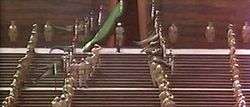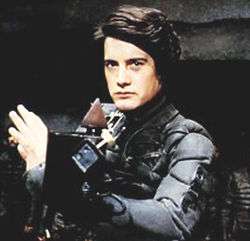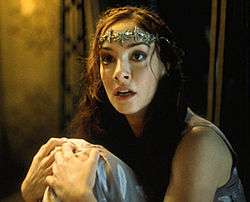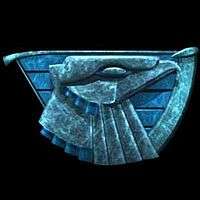House Atreides

House Atreides /əˈtreɪdiːz/[1] is a fictional noble family from the Dune universe created by Frank Herbert. One of the Great Houses of the feudal interstellar empire known as the Imperium, its members play a role in every novel in the series. It is suggested within the series that the root of the Atreides line is the mythological Greek House of Atreus. In Homer's Iliad, the brothers Agamemnon and Menelaus are dubbed "the Atreides," or, sons of Atreus.
House Atreides rules the water planet of Caladan, employing noble spirit, just ways and virtue in its endeavors. Also proficient in war, the family has even developed an Atreides battle language (in the 1984 film version, this language is presented as a system of hand signals; the novels also include a spoken language). The colors of House Atreides are green and black, and their symbol is a red hawk.
The original series
Dune


At the time of the original novel Dune (1965), House Atreides is led by the Duke Leto Atreides. His concubine is the Bene Gesserit Lady Jessica; she had been instructed by her order to bear only female children as part of their breeding program, but out of love for Leto, she bore him a son: Paul Atreides. This seemingly innocuous choice would drastically change the course of humanity forever.[2]
A millennia-long feud exists between the Atreides and the decadent House Harkonnen, who have essentially bought their status while the Atreides are related to the Emperor by blood.[3] The fact that an Atreides once had a Harkonnen banished for cowardice in ancient times is still bitterly remembered some 10,000 years later.[3] The Atreides are lured to the desert planet Arrakis under the pretense of taking over the spice-mining operation there.[2] The spice is the most valuable commodity in the universe — it makes interstellar travel possible, extends life and can unlock dormant abilities in the Bene Gesserit — and Arrakis is its only known source.[2] But Leto and his family are caught in a plot to destroy them, orchestrated by the Baron Harkonnen and Padishah Emperor Shaddam IV himself, who is threatened by Leto's rising power and influence.[2]
An attack on the Atreides, assisted by a Harkonnen traitor in their midst and the Imperial Sardaukar soldier-fanatics, results in Leto's death. Paul and Jessica flee into the desert and are presumed dead; they find a place with the native Fremen, who believe Paul is their prophesied messiah, the Mahdi. Jessica gives birth to Leto's daughter, Alia; whom the Bene Gesserit call an Abomination because Jessica, while still pregnant, underwent the ritual spice agony, thus inadvertently awakening Alia to full consciousness in the womb. Paul himself decides to go through the spice agony to test whether he may be the Kwisatz Haderach, and succeeds. As a result of Jessica's earlier choice to have a son, the goal of the Bene Gesserit breeding program; the Kwisatz Haderach was born a generation early, went unnoticed and lived outside of the Sisterhood's control. Soon Paul is able to amass an army of Fremen, their fierce fighting skills enhanced by training in the Bene Gesserit martial arts the Fremen call the "weirding way". He and his Fremen concubine Chani have a son they call Leto, but the boy is killed in infancy as the battle for Arrakis intensifies. Now called Muad'Dib, Paul leads the Fremen forces to victory over the Emperor's Sardaukar on Arrakis, and by threatening the destruction of all spice production manages to depose Shaddam and ascend the throne in his place.[2]
Dune Messiah
Over a decade later in Dune Messiah (1969), Emperor Paul remains in a political marriage with Shaddam's eldest daughter, Princess Irulan, and has yet to beget another child with his true love Chani. His rule is threatened by a conspiracy spun by the other major powers in the Imperium: the Bene Gesserit, the Spacing Guild, the Bene Tleilax, Irulan herself and even some of the Fremen. All have reasons to resent his stranglehold on the universe and the jihad it has unleashed. Paul lets these plots play out and manages to keep his Empire intact, but not without a price; he is blinded by the explosion of a stone burner, and Chani dies giving birth to his only heirs, the twins Leto II and Ghanima. Paul disappears into the desert, in accordance with Fremen custom for the blind, leaving Alia as Imperial Regent and guardian of his son and daughter.
Children of Dune

In Children of Dune (1976), Leto II and Ghanima are uncertain of the future. Nine years old but mature beyond their years due to their also being pre-born, the pair maneuver around the ever-increasing machinations of their aunt Alia, who is slowly but surely succumbing to Abomination. Alia herself is wary of the Lady Jessica, returned from Caladan with questionable intentions. The ego-memory of the evil Baron Harkonnen, Jessica's secret father, seduces Alia from within, promising his help in fighting off the multitude of ancestral personalities struggling for control. Soon, however, he himself has possessed her. Alia's subsequent attempt to eliminate her mother — as well as a Corrino plot to assassinate the twins — sets off a Fremen rebellion and puts the religion of Muad'Dib in turmoil. As Leto's eyes are opened to the Golden Path that will save humanity, a mysterious blind man known as The Preacher appears to undermine Alia and her priests in the eyes of the people. He, of course, is Paul Atreides. Leto sacrifices his humanity and, for the sake of the survival of the human race, chooses to accept transformation into a sandworm, the fearsome giant beasts of Arrakis which actually control the spice cycle. He delves into a pool of sandtrout, which form a living skin around him; his resulting body is superhuman, becoming nearly invulnerable, capable of tremendous speed and possessing the strength of many men. Paul is killed, but Leto's ascension is now guaranteed. Alia, fully fallen into madness, manages to regain control of her body long enough to leap out a high window to her death. Leto weds his sister Ghanima in a political union to consolidate power; unable to father children, he instead intends for her to take Farad'n of House Corrino as a mate. This union will produce a long bloodline, which Leto will manipulate in his own breeding program to achieve the goals of his Golden Path.
God Emperor of Dune
Over 3,500 years later, a seemingly-immortal Leto is the title character in God Emperor of Dune (1981). Known as the Tyrant, he has dominated humanity to a breaking point; he himself has become a full human-worm hybrid, immense in size and physically more sandworm than human. His breeding program has resulted in the birth of Siona Atreides (daughter of Moneo), who possesses unique genes that make her invisible to prescience. Ready to let the final stage of his Golden Path play itself out, Leto allows Siona's plan to assassinate him to unfold. He dies, leaving Siona and the latest Duncan Idaho ghola continue the Atreides line and pass on Siona's precious genes.
Heretics of Dune and Chapterhouse Dune
Another 1,500 years passes; in the interim, humanity has been thrown into chaos. The breakdown of Leto's empire, severe famine on many worlds and the introduction of Ixian navigation machines have caused billions of people to leave the settled worlds, striking off into unknown space in a diaspora known as the Scattering. This resettlement was one of Leto's goals for humanity's ultimate survival: the exponential growth in human numbers and colonized planets, combined with the dissemination of Siona's genes which render their bearer invisible to prescience, ensuring humanity's survival by making it impossible for any one force to track down every human in the universe or to control them all through prescience (which forces the future to happen according to the vision of the prescient).
In Heretics of Dune (1984), one descendant of Siona Atreides is Miles Teg, renowned commander of the military forces of the Bene Gesserit, who bears a remarkable resemblance to his ancestor, Duke Leto I. Teg's secret daughter is Darwi Odrade (a variant on Atreides), a Bene Gesserit sister who eventually becomes Mother Superior of the Sisterhood during their ongoing struggle with the fierce Honored Matres.
1985's Chapterhouse: Dune finds the Tleilaxu Master Scytale a prisoner of the Bene Gesserit; one of his secret bargaining chips is a nullentropy capsule containing cells carefully and secretly collected by the Tleilaxu for millennia. These cells include those of Paul Atreides, Duke Leto Atreides and Leto II, Lady Jessica, Chani and other legendary figures.
Prelude to Dune
| The Dukes Atreides | |
|---|---|
| Name | Reign |
| Miklos Atreides[4] | Unknown |
| Kean Atreides[5] | Unknown |
| Paulus Atreides | ??? - 10,156 A.G. |
| Leto I Atreides | 10,140 - 10,191 A.G. |
| Emperor Paul Atreides |
10,191 - 10,209 A.G. |
| Imperial Regent Alia Atreides |
10,209 - 10,219 A.G. |
| Leto II Atreides "The God Emperor" |
10,219 - 13,728 A.G. |
| Abolition of Ducal and Imperial thrones | |
The prequel trilogy Prelude to Dune (1999–2001) by Brian Herbert and Kevin J. Anderson chronicles the upbringing of young Leto I prior to the events of Dune. Son to Duke Paulus Atreides (born 10,089 A.G.) and Lady Helena (born 10,095 A.G.), Leto makes a lifelong friend in Rhombur Vernius, son of Paulus' own longtime ally, Earl Dominic of the doomed House Vernius of Ix.
Icy and religious Lady Helena, daughter of Count Ilban of House Richese, is unhappy with the alliance; Richese and Ix are rivals in the production of complex machinery, and she believes the Ixians often flout the sacred proscriptions of the Butlerian Jihad, which prohibit the creation of machines "in the likeness of the human mind." Helena plots against her husband, hoping to rule through her son; she arranges for a Salusan bull to be drugged to make it stronger and more savage, knowing that skilled bullfighter Paulus is set to meet it in the ring. Paulus is killed, and soon Leto's suspicions of his mother's involvement are proven correct. Preferring to have her executed, he instead banishes her to the Sisters of Isolation, knowing it is in the best interest of the people that no one ever knows of her treachery.
Mythological origins
In the original novels, House Atreides claims descent from Agamemnon, a son of Atreus, in Greek mythology. The descendants of Atreus are called "Atreides" (plural "Atreidai", Latinized as "Atreidae") in the Greek language. This royal house included many significant figures in Greek myth. In Homer's Iliad, Agamemnon and his brother Menelaus are each Ἀτρεΐδης, a "son of Atreus",[6][7] the "Atreides" when pronounced and translated into English.
In the Brian Herbert/Kevin J. Anderson Legends of Dune novels, the Atreides family line goes back to the Greeks on Old Earth. Vorian Atreides was the thirteenth son of the Titan Agamemnon, one of the twenty Titans who conquered the Old Empire, and was a Human Trustee in Omnius' Machine Empire. He began the family house of the Atreides and was Muad'Dib's ancestor.
Atreides family tree
The following family tree assembles information from Frank Herbert's original novels as well as the prequel series Legends of Dune, Schools of Dune and Prelude to Dune.
| Atreus | |||||||||||||||||||||||||||||||||||||||||||||||
| Agamemnon b. circa 1200 B.C. | |||||||||||||||||||||||||||||||||||||||||||||||
| Agamemnon (born Andrew Skouros) circa 1300 - 88 B.G. | |||||||||||||||||||||||||||||||||||||||||||||||
| Leronica Tergiet 201 - 108 B.G. | Vorian Atreides b. 223 B.G. | Karida Julan | Hyla d. 5 B.G. | Andros d. 5 B.G. | |||||||||||||||||||||||||||||||||||||||||||
| Estes Vazz b. 173 B.G. | Kagin Vazz b. 173 B.G. | Mariella Atreides d. 5 B.G. | Helmina Berto-Anirul d. 115 B.G. | ||||||||||||||||||||||||||||||||||||||||||||
| Bonda Atreides | Clar Atreides | Oren Atreides | Raquella Berto-Anirul b. 137 B.G. | ||||||||||||||||||||||||||||||||||||||||||||
| House Vernius | House Richese | House Corrino | Arlett | ||||||||||||||||||||||||||||||||||||||||||||
| Miklos Atreides | Yvette Hagal 10,024 - 10,075 A.G. | Elrood IX Corrino 9,999 - 10,156 A.G. | Dorotea | ||||||||||||||||||||||||||||||||||||||||||||
| Kean Atreides | Ilban Richese | Edwina Corrino 10,070 - 10,123 A.G. | House Harkonnen | Bene Gesserit | |||||||||||||||||||||||||||||||||||||||||||
| Paulus Atreides 10,089 - 10,156 A.G. | Helena Richese b. 10,095 A.G. | Vladimir Harkonnen 10,110 - 10,193 A.G. | Tanidia Nerus (Gaius Helen Mohiam) d. 10,207 A.G. | ||||||||||||||||||||||||||||||||||||||||||||
| Kailea Vernius d. 10,174 A.G. | Leto I Atreides 10,140 - 10,191 A.G. | Lady Jessica 10,154 - 10,256 A.G. | |||||||||||||||||||||||||||||||||||||||||||||
| Victor Atreides 10,168 - 10,174 A.G. | Paul Atreides 10,176 - 10,219 A.G. | Chani d. 10,207 A.G. | Alia Atreides 10,191 - 10,219 A.G. | ||||||||||||||||||||||||||||||||||||||||||||
| Leto Atreides (10,193 - 10,195 A.G.) | Leto II Atreides 10,207 - 13,728 A.G. | Ghanima Atreides b. 10,207 A.G. | Farad'n Corrino b. 10,198 A.G. | ||||||||||||||||||||||||||||||||||||||||||||
| Moneo Atreides 13,610-13,728 A.G. | |||||||||||||||||||||||||||||||||||||||||||||||
| Duncan Idaho | Siona Atreides | ||||||||||||||||||||||||||||||||||||||||||||||
| Miles Teg | |||||||||||||||||||||||||||||||||||||||||||||||
| Darwi Odrade | |||||||||||||||||||||||||||||||||||||||||||||||
The Atreides in the Dune games

House Atreides has been featured in all of the Dune computer games:
| Game | Notes | ||||||
|---|---|---|---|---|---|---|---|
| Dune | The game casts the player as Paul Atreides, with the goal of driving the Harkonnens out of spice management. | ||||||
| Dune II | - House Atreides' color is blue in this game, green being taken by House Ordos.
- House Atreides' special weapon, the Sonic Tank is a powerful fighting vehicle. Although it has only medium armor and slow moving speed, its sonic oscillator fires heavy sonic shockwaves to long distances, being particularly effective against infantry and structures. The sonic waves damage everything in their path, therefore the Sonic Tank must be used with caution. - The native population of Dune, the Fremen are fighting alongside House Atreides. Groups of Fremen troopers may be called from time to time, they shall attack any hostile units the player can see. They ignore structures, unless the player have chosen another house. When Fremen are enemies, they DO attack buildings as well. - House Atreides can build Ornithopters in their High-tech Facilities, once it gets upgraded. | ||||||
| Dune 2000 | - Combat tanks of Atreides design are adequate in both armor and speed. The Harkonnen version is stronger in armor but slower, whilst the Ordos version is faster but has less armor.
- When an Atreides High-tech Facility is built, it can be upgraded to provide airstrikes. The airstrike is free and recharges time to time, it can be ordered to any location. Three Ornithopters shall arrive, dropping bombs to the target zone three times. Only Missile tanks and Rocket turrets pose a threat to them. - The Dune 2000 version of the Sonic Tank is a tad different. Its armor is much stronger, and its speed is also slower. The sonic oscillator it uses has a slightly shorter range, and the tank has a weak spot right at the front. If an enemy unit is right in front of the Sonic Tank (at the focal point), it suffers very little damage. - Once the Atreides Palace is built, two Fremen can be summoned at once. Fremen in Dune 2000 are stealth units, they cannot be seen by enemies until they are next to infantrymen or base defense turrets. Their guns are effective against vehicles and infantry as well. |
||||||
| Emperor: Battle for Dune | The alliance between the Atreides and the Fremen is dissolved, but can still be forged. Atreides are still blue. | ||||||
| Frank Herbert's Dune | Cast as Paul Atreides, the player must win the trust of the Fremen on Arrakis and defeat Baron Harkonnen. | ||||||
Footnotes
- ↑ Herbert's Dune repeatedly references the "green and black banner of the Atreides"; the arrangement of the colours and the shape of the flag are never specified. The original novel makes reference to "guidon pennants" being used as banners of noble houses (specifically on Giedi Prime: the planet's "Houses Minor", as well as the ruling House Harkonnen itself, are described as using guidons).
References
- ↑ Dune: Creating the Audiobooks (Official promotional video, includes images of Frank Herbert's pronunciation notes for some terms). Macmillan Audio. December 23, 2008. Event occurs at 4:04. Retrieved January 23, 2010.
- 1 2 3 4 5 Herbert, Frank (1965). Dune.
- 1 2 Herbert, Frank (1965). Dune.
The Harkonnens won't rest until they're dead or my Duke destroyed. The Baron cannot forget that Leto is a cousin of the royal blood — no matter what the distance — while the Harkonnen titles came out of the CHOAM pocketbook. But the poison in him, deep in his mind, is the knowledge that an Atreides had a Harkonnen banished for cowardice after the Battle of Corrin.
- ↑ Herbert, Brian; Anderson, Kevin J. Dune: House Harkonnen. "THE STATUE of Leto's paternal great-grandfather, Duke Miklos Atreides, stood tall in the courtyard of the Cala City Hospital, stained by time and moss and guano. As Leto passed the serene visage of an ancestor he had never known, he nodded in habitual respect, then hurried up a set of wide marblecrete stairs."
- ↑ Herbert, Brian; Anderson, Kevin J. Dune: House Atreides. "Faces from his past scrolled across his mind, and he locked on to a memory of his paternal grandfather Kean Atreides gazing at him with expectation, his face a crease-map of his life experiences. Gentle gray eyes like his own held a disarming strength that his enemies often overlooked, to their great peril."
- ↑ "Homer, Iliad, Book 1". Perseus.Tufts.edu. p. Line 7. Retrieved March 26, 2016.
- ↑ "Greek Study Tool: Ἀτρεΐδης". Perseus.Tufts.edu. Retrieved March 26, 2016.
